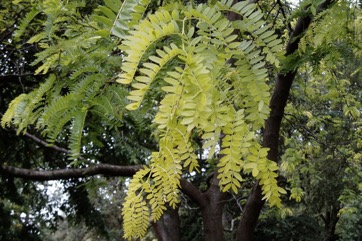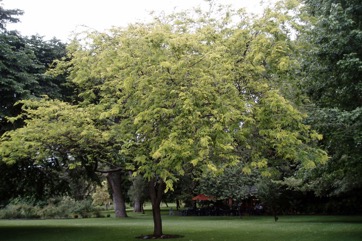Honey locust, Thorny locust

A warm temperate plant. It will grow on most soils if there is adequate moisture. It does best in a protected sunny position. They cannot tolerate shade. It is damaged by drought but resistant to frost. It prefers long hot summers so seed are not always produced in coastal regions. Trees are frost tender when young but withstand heavy frosts once established. It can grow on alkaline soils. It grows from sea level to about 2,000 m above sea level in Africa. It can grow in arid places. It suits hardiness zones 3-10. Hobart Botanical Gardens.
Also known as:
Honeyshuck, Sweet bean, Sweet locust
Synonyms
- Acacia americana Stokes
- Acacia inermis Steudel
- Acacia laevis Steudel
- Caesalpiniodes triacanthum (L.) Kuntze
- Gleditsia brachycarpa (Michaux) Pursh
- Gleditsia bujotii Neumann
- Gleditsia bujotii Neumann var. pendula Rehder
- Gleditsia elegans Salisb.
- Gleditsia ferox Desf. var. nana Rehder
- Gleditsia flava Steudel
- Gleditsia heterophylla Raf.
- Gleditsia horrida Salisb.
- Gleditsia inermis L.
- Gleditsia inermis L. var. elegantissims Ch. Grosdenange
- Gleditsia laevis D. Don.
- Gleditsia latifolia Lavallee
- Gleditsia latisilique Steudel
- Gleditsia metiloba Walter
- Gleditsia micrantha Steudel
- Gleditsia polysperma Stokes
- Gleditsia sinensis Lam. var. nana Asch. & Graebner
- Gleditsia sinensis Lam. var. nana Louden
- Gleditsia spinosa Marsh.
- Gleditsia triacanthos L. var. brachycarpus Michaux
- Gleditsia triacanthos L. var. bujotii (Neumann) Rehder
- Gleditsia triacanthos L. var. horrida Aiton
- Gleditsia triacanthos L. var. inermis (L.) Castigl.
- Gleditsia triacanthos L. var. inermis Willd.
- Gleditsia triacanthos L. var. laevis Koch
- Gleditsia triacanthos L. var. macrocarpos Michaux
- Gleditsia triacanthos L. var. nana Henry
- Gleditsia triacanthos L. var. polysperma Aiton
- Gleditsia triacanthos Miller
- Melilobus heterophyla Raf.
Edible Portion
- Pulp, Seeds, Fruit, Seeds - coffee
Where does Honey locust grow?
Found in: Afghanistan, Africa, Argentina, Asia, Australia, Austria, Britain, Bulgaria, Canada, China, Czech Republic, East Africa, Easter island, Europe, France, Germany, Hungary, India, Iran, Iraq, Italy, Lesotho, Macedonia, Mauritius, Mediterranean, Morocco, Mozambique, New Zealand, North Africa, North America, Pacific, Pakistan, Papua New Guinea, PNG, Portugal, Romania, Russia, South Africa, Southern Africa, South America, Spain, Syria, Tasmania, Tunisia, Turkey, Uganda, Uruguay, United States, Yugoslavia, Zimbabwe
Notes: Seeds contain 10.6 - 24.1% protein, 0.8 - 4.3% fat, 84.7% carbohydrate, 21.1% fibre, 4% ash, 280 mg calcium and 320 mg phosphorus per 100g[218]. There are about 14 Gleditsia species. Also as Caesalpinaceae.
Growing Honey locust, Thorny locust
Cultivation: Plants are grown from seed. The seeds have a hard coat. The seeds need treatment to help them start to grow. They should be pre-soaked for 24 hours in warm water before sowing. Filing the seed coat can also assist. The seeds can also be put in acid. Plants can be budded or grafted. If cuttings are taken from shoots of only one sex they will only produce those flowers and not fruit. Plants can be cut back and will re-grow.
Edible Uses: The young seed can be eaten raw or cooked. They are sweet. They are also used for a fermented drink. They are roasted as a coffee substitute. The pulp of the pod can be eaten. A sweet drink can be made from the seed pods. CAUTION: The twigs and the leaves contain the alkaloids gleditschine and stenocarpine. Stenocarpine has been used as a local anaesthetic whilst gleditschine causes stupor and loss of reflex activity. The leaves are under investigation as potential cancer cures.
Production: A fast growing tree. Seed germinate in 2-4 weeks at 20°C. Trees start to produce seed when 10 years old and can produce for 100 years. Trees can live for 120 years.
Nutrition Info
per 100g edible portion| Edible Part | Energy (kcal) | Protein (g) | Iron (mg) | Vitamin A (ug) | Vitamin c (mg) | Zinc (mg) | % Water |
|---|---|---|---|---|---|---|---|
| - | - | - | - | - | - | ||
| - | - | - | - | - | - |
Honey locust, Thorny locust Photos


References
Ambasta, S.P. (Ed.), 2000, The Useful Plants of India. CSIR India. p 237
Beckstrom-Sternberg, Stephen M., and James A. Duke. "The Foodplant Database." http://probe.nalusda.gov:8300/cgi-bin/browse/foodplantdb.(ACEDB version 4.0 - data version July 1994)
Blamey, M and Grey-Wilson, C., 2005, Wild flowers of the Mediterranean. A & C Black London. p 110
Bodkin, F., 1991, Encyclopedia Botanica. Cornstalk publishing, p 498
Brickell, C. (Ed.), 1999, The Royal Horticultural Society A-Z Encyclopedia of Garden Plants. Convent Garden Books. p 476
Coombes, A.J., 2000, Trees. Dorling Kindersley Handbooks. p 195
Cundall, P., (ed.), 2004, Gardening Australia: flora: the gardener's bible. ABC Books. p 641
Denes, A., et al, 2012, Wild plants used for food by Hungarian ethnic groups living in the Carpathian Basin. Acta Societatis Botanicorum Poloniae 81 (4): 381-396
Duke, J.A., 1992, Handbook of Edible Weeds. CRC Press. p 106
Etherington, K., & Imwold, D., (Eds), 2001, Botanica's Trees & Shrubs. The illustrated A-Z of over 8500 trees and shrubs. Random House, Australia. p 347
Fabaceae Illustrated Flora of Central Texas p 662
Facciola, S., 1998, Cornucopia 2: a Source Book of Edible Plants. Kampong Publications, p 68
Farrar, J.L., 1995, Trees of the Northern United States and Canada. Iowa State University press/Ames p 216
Flora of Australia Volume 12, Mimosaceae (excl. Acacia) Caesalpiniaceae. Melbourne: CSIRO Australia (1998) p 56
Flora of Pakistan. www.eFloras.org
Fox, F. W. & Young, M. E. N., 1982, Food from the Veld. Delta Books. p 226
Gouldstone, S., 1983, Growing your own Food-bearing Plants in Australia. Macmillan p 170
Grandtner, M. M., 2008, World Dictionary of Trees. Wood and Forest Science Department. Laval University, Quebec, Qc Canada. (Internet database http://www.wdt.qc.ca)
Hall, N. et al, 1972, The Use of Trees and Shrubs in the Dry Country of Australia, AGPS, Canberra. p 393
Harris, E & J., 1983, Field Guide to the Trees and Shrubs of Britain. Reader's Digest. p 175
Hedrick, U.P., 1919, (Ed.), Sturtevant's edible plants of the world. p 329
Hussey, B.M.J., Keighery, G.J., Cousens, R.D., Dodd, J., Lloyd, S.G., 1997, Western Weeds. A guide to the weeds of Western Australia. Plant Protection Society of Western Australia. p 124
ILDIS Legumes of the World http:www:ildis.org/Legume/Web
Jackes, D. A., Edible Forest Gardens
Joyce, D., 1998, The Garden Plant Selector. Ryland, Peters and Small. p 112
Kiple, K.F. & Ornelas, K.C., (eds), 2000, The Cambridge World History of Food. CUP p 1786
Lazarides, M. & Hince, B., 1993, Handbook of Economic Plants of Australia, CSIRO. p 121
Little, E.L., 1980, National Audubon Society Field Guide to North American Trees. Alfred A. Knopf. p 523
Lord, E.E., & Willis, J.H., 1999, Shrubs and Trees for Australian gardens. Lothian. p 56
Lyle, S., 2006, Discovering fruit and nuts. Land Links. p 229
Moerman, D. F., 2010, Native American Ethnobotany. Timber Press. p 248
Plants for a Future database, The Field, Penpol, Lostwithiel, Cornwall, PL22 0NG, UK. http://www.scs.leeds.ac.uk/pfaf/
Recher, P, 2001, Fruit Spirit Botanical Gardens Plant Index. www.nrg.com.au/~recher/ seedlist.html p 2
Royal Botanic Gardens, Kew (1999). Survey of Economic Plants for Arid and Semi-Arid Lands (SEPASAL) database. Published on the Internet; http://www.rbgkew.org.uk/ceb/sepasal/internet [Accessed 21st April 2011]
Ruiters-Welcome, A. K., 2019, Food plants of southern Africa. Ph.D. thesis. Univ. of Johannesburg p 58
Self, M., 199, Phoenix Seeds catalogue. p 15
Sp. pl. 2:1056. 1753
van Wyk, Ben-Erik, 2019, The diversity and multiple uses of southern African legumes. Australian Systematic Botany, 2019, 32, 519–546
World Checklist of Useful Plant Species 2020. Royal Botanic Gardens, Kew
www.worldagroforestrycentre.org/treedb/
Young, J., (Ed.), 2001, Botanica's Pocket Trees and Shrubs. Random House. p 413
Zizka, G., 1991, Flowering Plants of Easter Island. Palmarum Hortus Francofurtensis